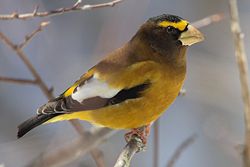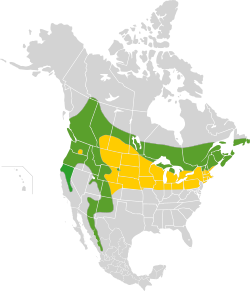- Hesperiphona vespertina
-
Grosbec errant
Grosbec errant

Coccothraustes vespertinus Classification classique Règne Animalia Embranchement Chordata Sous-embr. Vertebrata Classe Aves Ordre Passeriformes Famille Fringillidae Sous-famille Carduelinae Genre Coccothraustes Nom binominal Coccothraustes vespertinus
(Cooper, 1825)
Vert: présent toute l'année, jaune: zone d'hivernage
Statut de conservation IUCN :
 Retrouvez ce taxon sur Wikispecies
Retrouvez ce taxon sur Wikispecies
D'autres documents multimédia
sont disponibles sur CommonsParcourez la biologie sur Wikipédia : Le Grosbec errant (Coccothraustes vespertinus) est un oiseau granivore appartenant à la famille des Fringillidae. Auparavant, il était placé dans son propre genre Hesperiphona vespertina mais à présent il est habituellement placé dans le même genre que le Gros-bec casse-noyaux d’Eurasie.
Sommaire
Description
Le Grosbec errant mesure 18,5 centimètres. L’adulte possède une courte queue noire, des ailes noires et un large bec pâle. Le corps et le front du mâle adulte sont jaunes ; sa tête est brune et il présente une grande tache blanche à l’aile. Le plumage de la femelle adulte est brun olivâtre, le dessus est plus gris et les ailes montrent des taches blanches.
Répartition
La migration de cette espèce est variable; certains hivers, on la retrouve jusqu’au sud des États-Unis. La répartition du Grosbec errant s’est étendue vers l’est, possiblement à cause de la plantation d’érables negundos et d’autres érables et arbustes autour des fermes, et de la présence de mangeoires en hiver.
Habitat et comportements
Le Grosbec errant niche dans des forêts mixtes ou de conifères au Canada et dans les zones montagneuses de l’ouest des États-Unis et du Mexique. Le nid est construit sur une branche horizontale ou dans la fourche d’un arbre.
Les individus se nourrissent dans les arbres et les arbustes, quelquefois au sol. Ils consomment principalement des graines, des baies et des insectes. En dehors de la saison de nidification, les individus se déplacent souvent en groupe.
Galerie
Grosbec errant Références externes
- Référence Avibase : Coccothraustes vespertinus (+répartition) (fr+en)
- Référence Oiseaux.net : Coccothraustes vespertinus (+répartition) (fr)
- Référence ITIS : Coccothraustes vespertinus (Cooper, 1825) (fr) ( (en))
- Référence Animal Diversity Web : Coccothraustes vespertinus (en)
- Référence NCBI : Coccothraustes vespertinus (en)
- Référence IUCN : espèce Coccothraustes vespertinus (Cooper, 1825) (en)
- Grosbec errant dans Faune et flore du pays
Informations supplémentaires
Livre
- Gillihan, S. W., et B. Byers. 2001. Evening Grosbeak (Coccothraustes verspertinus). Dans The Birds of North America, No. 599 (A. Poole et F. Gill, eds.). The Birds of North America, Inc., Philadelphia, PA.
Thèse
- Prescott DRC. Ph.D. (1992). Differential migration in the evening grosbeak (Coccothraustes vespertinus): A test of hypotheses. University of Calgary (Canada), Canada.
Articles scientifiques
- Bekoff M. (1995). Cognitive ethology, vigilance, information gathering, and representation: Who might know what and why?. Behavioural Processes. vol 35, no 1-3. p. 225-237.
- Bekoff M. (1995). Vigilance, Flock Size, and Flock Geometry: Information Gathering by Western Evening Grosbeaks (Aves, Fringillidae). Ethology. vol 99, no 2. p. 150-161.
- Bekoff M, Scott AC & Conner DA. (1987). Nonrandom Nest-Site Selection in Evening Grosbeaks. Condor. vol 89, no 4. p. 819-829.
- Bekoff M, Scott AC & Conner DA. (1989). Ecological Analyses of Nesting Success in Evening Grosbeaks. Oecologia. vol 81, no 1. p. 67-74.
- Bennetts RE & Hutto RL. (1985). Attraction of Social Fringillids to Mineral Salts an Experimental Study. Journal of Field Ornithology. vol 56, no 2. p. 187-189.
- Brunswig NL, Winton SG & Hamel PB. (1983). A Dietary Overlap of Evening Grosbeaks Coccothraustes-Vespertinus and Carolina Parakeets Conuropsis-Carolinensis. Wilson Bulletin. vol 95, no 3.
- Cumming EE & Diamond AW. (2002). Songbird community composition versus forest rotation age in Saskatchewan boreal mixedwood forest. Canadian Field Naturalist. vol 116, no 1. p. 69-75.
- Daoust PY, Busby DG, Ferns L, Goltz J, McBurney S, Poppe C & Whitney H. (2000). Salmonellosis in songbirds in the Canadian Atlantic provinces during winter-summer 1997-98. Canadian Veterinary Journal-Revue Veterinaire Canadienne. vol 41, no 1. p. 54-59.
- Dean J. (1985). An Extraordinary Evening Grosbeak. Ontario Bird Banding. vol 17, no 17.
- Desser SS. (1980). An Ultrastructural Study of the Asexual Development of a Presumed Isospora-Sp in Mononuclear Phagocytic Cells of the Evening Grosbeak Hesperiphona-Vespertina. Journal of Parasitology. vol 66, no 4. p. 601-612.
- Fee BA & Bekoff M. (1986). POLYGYNY IN THE EVENING GROSBEAK. Wilson Bulletin. vol 98, no 2. p. 308-308.
- Garrison BA, Triggs ML & Wachs RL. (2005). Short-term effects of group-selection timber harvest on landbirds in montane hardwood-conifer habitat in the central Sierra Nevada. Journal of Field Ornithology. vol 76, no 1. p. 72-82.
- Gilbert FF & Allwine R. (1991). Spring Bird Communities in the Oregon Cascade Range USA. U S Forest Service General Technical Report PNW. vol 285, p. 145-159.
- Gillihan SW & Byers B. (2001). Evening Grosbeak: Coccothraustes vespertinus. Birds of North America. vol 599, p. 1-23.
- Hagar JC, McComb WC & Emmingham WH. (1996). Bird communities in commercially thinned and unthinned Douglas-fir stands of western Oregon. Wildlife Society Bulletin. vol 24, no 2. p. 353-366.
- Hahn TP, Kelsey TR & Pereyra ME. (2001). Geographic variation in flight calls of a nomadic cardueline finch, the evening grosbeak (Coccothraustes vespertinus). American Zoologist. vol 41, no 6. p. 1462-1463.
- Hayes JP, Weikel JM & Huso MMP. (2003). Response of birds to thinning young Douglas-fir forests. Ecological Applications. vol 13, no 5. p. 1222-1232.
- Helleiner CW. (1979). Xanthochroism in the Evening Grosbeak. Canadian Field Naturalist. vol 93, no 1. p. 66-67.
- Hudon J. (1997). Non-melanic schizochroism in Alberta Evening Grosbeaks, Coccothraustes vespertinus. Canadian Field Naturalist. vol 111, no 4. p. 652-654.
- Kinch B. (2006). Northern Shrike preys on Pine Grosbeak. Ontario Birds. vol 24, no 3. p. 160-161.
- Koenig WD & Knops JMH. (2001). Seed-crop size and eruptions of North American boreal seed-eating birds. Journal of Animal Ecology. vol 70, no 4. p. 609-620.
- Langelier LA & Garton EO. (1986). Management Guidelines for Increasing Populations of Birds That Feed on Western Spruce Budworm. U S Department of Agriculture Agriculture Handbook. vol 653, p. 1-19.
- LeBaron GS. (2000). The one-hundred first Christmas Bird Count. American Birds. vol 101, p. 6-12.
- Levine ND. (1982). The Genus Atoxoplasma Protozoa Apicomplexa. Journal of Parasitology. vol 68, no 4. p. 719-723.
- Manuwal DA. (1991). Spring Bird Communities in the Southern Washington Cascade Range USA. U S Forest Service General Technical Report PNW. vol 285, p. 161-175.
- McGraw KJ, Beebee MD, Hill GE & Parker RS. (2003). Lutein-based plumage coloration in songbirds is a consequence of selective pigment incorporation into feathers. Comparative Biochemistry & Physiology Part B Biochemistry & Molecular Biology 135B. vol 4, p. 689-696.
- McGraw KJ, Hudon J, Hill GE & Parker RS. (2005). A simple and inexpensive chemical test for behavioral ecologists to determine the presence of carotenoid pigments in animal tissues. Behavioral Ecology & Sociobiology. vol 57, no 4. p. 391-397.
- Mikaelian I, Ley DH, Claveau R, Lemieux M & Berube J-P. (2001). Mycoplasmosis in evening and pine grosbeaks with conjunctivitis in Quebec. Journal of Wildlife Diseases. vol 37, no 4. p. 826-830.
- Mindell DP & Sites JWJ. (1987). Tissue Expression Patterns of Avian Isozymes a Preliminary Study of Phylogenetic Applications. Systematic Zoology. vol 36, no 2. p. 137-152.
- O'Hara PD, Fernandez G, Haase B, de la Cueva H & Lank DB. (2006). Differential migration in Western Sandpipers with respect to body size and wing length. Condor. vol 108, no 1. p. 225-232.
- Prescott DRC. (1991). Winter Distribution of Age and Sex Classes in an Irruptive Migrant the Evening Grosbeak Coccothraustes-Vespertinus. Condor. vol 93, no 3. p. 694-700.
- Prescott DRC. (1994). Intraspecific and geographical trends in body size of a differential migrant, the Evening Grosbeak. Auk. vol 111, no 3. p. 693-702.
- Scott AC & Bekoff M. (1991). Breeding Behavior of Evening Grosbeaks. Condor. vol 93, no 1. p. 71-81.
- Sewall K, Kelsey R & Hahn TP. (2004). Discrete variants of Evening Grosbeak flight calls. Condor. vol 106, no 1. p. 161-165.
- Svingen D & Rogers TH. (1994). Winter Season: Idaho/Western Montana Region. National Audubon Society Field Notes. vol 48, no 3. p. 320-322.
- Takekawa JY & Garton EO. (1984). HOW MUCH IS AN EVENING GROSBEAK WORTH. Journal of Forestry. vol 82, no 7. p. 426-428.
- Van Scheik WJ. (1994). Burrowing mites that pester birds. Blue Jay. vol 52, no 4. p. 204-205.
- Wilson WH, Jr. (1995). The distribution of wintering birds in central Maine: The interactive effects of landscape and bird feeders. Journal of Field Ornithology. vol 65, no 4. p. 512-519.
- Zach R & Mayoh KR. (1985). Gamma-Radiation-Induced Spatial Avoidance in Birds. Radiation Research. vol 104, no 1. p. 66-70.
- Portail de l’ornithologie
Catégories : Statut IUCN Préoccupation mineure | Oiseau (nom vernaculaire) | Carduelinae
Wikimedia Foundation. 2010.


